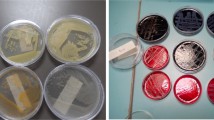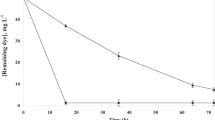Abstract
Textile wastewaters are usually alkali and saline, so using haloalkaliphilic bacteria can be the best option for the treatment of wastewater. This study aimed at the decolorization of textile Reactive Black 5 and Reactive Red 152 dyes using new haloalkaliphilic bacteria isolated from the textile wastewater. Among 50 strains of bacteria isolated from the effluent of Kashan textile industry, three bacterial strains, namely D1, D2 and E49, exhibited high decolorization abilities for Reactive Black 5 and Reactive Red 152 dyes. Decolorization was evaluated through spectrophotometry at maximum absorbance wavelengths of 607 and 554 nm for Reactive Black 5 and Reactive Red 152, respectively. The highest decolorization percentage was observed at a dye concentration of 50 mg L−1. Aerobic conditions, 5% of the yeast extract and salt, 10% of peptone and glucose as nitrogen and carbon sources, respectively, and a pH range of 9–12 were considered as the optimal conditions for decolorization. The consortium of three haloalkaliphilic isolates showed a remarkable ability for decolorization of the Reactive Black 5 (87%) and Reactive Red 152 (85%) dyes. The consortium exhibited higher decolorization ability for the textile effluent, compared to individual bacterial inoculations. According to phenotypic characterization experiments and phylogenetic analyses based on comparing 16S rDNA sequence, the mentioned strains belonged to the genus Halomonas.





Similar content being viewed by others
References
Mondal P, Baksi S, Bose D (2017) Study of environmental issues in textile industries and recent wastewater treatment technology. World Sci News 61(2):98–109
Illakkiam D, Subha D, Ahila V, Geetha N (2016) Decolorization of alizarin red s dye by bacterial strains isolated from industrial effluents. Int J Plant Anim Environ Sci 6(1):268–275
Lourenco N, Novais J, Pinheiro H (2001) Effect of some operational parameters on textile dye biodegradation in a sequential batch reactor. J Biotechnol 89(2):163–174
Ghaly A, Ananthashankar R, Alhattab M, Ramakrishnan V (2014) Production, characterization and treatment of textile effluents: a critical review. J Chem Eng Process Technol 5(1):1
Wang LK, Hung Y-T, Lo HH, Yapijakis C (2004) Handbook of industrial and hazardous wastes treatment. CRC Press, Boca Raton
Zollinger H (1999) Colorimetry. In: Zollinger H (ed) Color: a multidisciplinary approach. Verlag Helvetica Chimica Acta, Zurich, pp 63–78
Muthukumar M, Karuppiah MT, Raju GB (2007) Electrochemical removal of CI Acid orange 10 from aqueous solutions. Sep purif technol 55(2):198–205
Kabbout R, Taha S (2014) Biodecolorization of textile dye effluent by biosorption on fungal biomass materials. Phys Procedia 55:437–444
Mahmood S, Arshad M, Khalid A, Nazli ZH, Mahmood T (2011) Isolation and screening of azo dye decolorizing bacterial isolates from dye-contaminated textile wastewater. Soil Environ 30(1):7–12
Chen K-C, Wu J-Y, Liou D-J, Hwang S-CJ (2003) Decolorization of the textile dyes by newly isolated bacterial strains. J Biotechnol 101(1):57–68
Asad S, Amoozegar M, Pourbabaee AA, Sarbolouki M, Dastgheib S (2007) Decolorization of textile azo dyes by newly isolated halophilic and halotolerant bacteria. Bioresour Technol 98(11):2082–2088
Khehra MS, Saini HS, Sharma DK, Chadha BS, Chimni SS (2005) Decolorization of various azo dyes by bacterial consortium. Dyes Pigm 67(1):55–61
Garg SK, Tripathi M, Singh SK, Tiwari JK (2012) Biodecolorization of textile dye effluent by Pseudomonas putida SKG-1 (MTCC 10510) under the conditions optimized for monoazo dye orange II color removal in simulated minimal salt medium. Int Biodeterior Biodegrad 74:24–35
Ahn D-H, Chang W-S, Yoon T-I (1999) Dyestuff wastewater treatment using chemical oxidation, physical adsorption and fixed bed biofilm process. Process Biochem 34(5):429–439
Oak U, Ghattargi V, Pawar S, Bhole B (2016) Degradation of Drimarene Red, a reactive textile dye by an extremophilic Bacillus sp. isolated from fresh water. Int J Appl Pure Sci Agric 2(3):105–113
Amoozegar MA, Hajighasemi M, Hamedi J, Asad S, Ventosa A (2011) Azo dye decolorization by halophilic and halotolerant microorganisms. Ann Microbiol 61(2):217–230
Dodia MS, Joshi RH, Patel RK, Singh SP (2006) Characterization and stability of extracellular alkaline proteases from halophilic and alkaliphilic bacteria isolated from saline habitat of coastal Gujarat, India. Braz J Microbiol 37(3):276–282
Eslami H, Shariatifar A, Rafiee E, Shiranian M, Salehi F, Hosseini SS, Eslami G, Ghanbari R, Ebrahimi AA (2019) Decolorization and biodegradation of reactive Red 198 Azo dye by a new Enterococcus faecalis–Klebsiella variicola bacterial consortium isolated from textile wastewater sludge. World J Microbiol Biotechnol 35(3):38
Burns D, Camakaris H, Janssen P, Dyall-Smith M (2004) Combined use of cultivation-dependent and cultivation-independent methods indicates that members of most haloarchaeal groups in an Australian crystallizer pond are cultivable. Appl Environ Microbiol 70(9):5258–5265
Bergey D, Buchanan R, Gibbons NASM (1974) Bergey’s manual of determinative bacteriology. Williams & Wilkins Co., Baltimore
Marmur J (1961) A procedure for the isolation of deoxyribonucleic acid from micro-organisms. J Mol Biol 3(2):208–218
Goodfellow M, Stackebrandt E (1991) Nucleic acid techniques in bacterial systematics, vol 5. Wiley, Chichester
Turner S, Pryer KM, Miao VP, Palmer JD (1999) Investigating deep phylogenetic relationships among cyanobacteria and plastids by small subunit rRNA sequence analysis. J Eukaryot Microbiol 46(4):327–338
Kashi FJ, Owlia P, Amoozegar MA, Yakhchali B, Kazemi B (2014) Diversity of cultivable microorganisms in the eastern part of Urmia salt lake, Iran. J Microbiol Biotechnol Food Sci 4(1):36
Yoon S-H, Ha S-M, Kwon S, Lim J, Kim Y, Seo H, Chun J (2017) Introducing EzBioCloud: a taxonomically united database of 16S rRNA gene sequences and whole-genome assemblies. Int J Syst Evol Microbiol 67(5):1613
Tamura K, Stecher G, Peterson D, Filipski A, Kumar S (2013) MEGA6: molecular evolutionary genetics analysis version 6.0. Mol Biol Evol 30(12):2725–2729
Pearce C, Lloyd J, Guthrie J (2003) The removal of colour from textile wastewater using whole bacterial cells: a review. Dyes Pigment 58(3):179–196
Wang H, Su JQ, Zheng XW, Tian Y, Xiong XJ, Zheng TL (2009) Bacterial decolorization and degradation of the reactive dye Reactive Red 180 by Citrobacter sp. CK3. Int Biodeterior Biodegrad 63(4):395–399
Suganya K, Revathi K, Anuradha V, Gopi K (2014) Optimization of parameters for decolorization of reactive dyes using bacterial isolates. Biosci Biotechnol Res Asia 11:339–342
Bayoumi R, Musa S, Bahobil A, Louboudy S, El-Sakawey T (2010) Biodecolorization and biodegradation of azo dyes by some bacterial isolates. J Appl Environ Biol Sci 1(1):1–25
Thakur JK, Paul S, Dureja P, Annapurna K, Padaria JC, Gopal M (2014) Degradation of sulphonated azo dye Red by Bacillus sp. and elucidation of degradative pathways. Curr Microbiol 69(2):183–191
Akdogan HA, Topuz MC, Urhan AA (2014) Studies on decolorization of Reactive Blue 19 textile dye by Coprinus plicatilis. J Environ Health Sci Eng 12(1):49
MohamedI WSE-D (2016) Isolation and screening of reactive dye decolorizing bacterial isolates from textile industry effluent. Int J Microbiol Res 7(1):1–8
Wang H, Zheng X-W, Su J-Q, Tian Y, Xiong X-J, Zheng T-L (2009) Biological decolorization of the reactive dyes Reactive Black 5 by a novel isolated bacterial strain Enterobacter sp. EC3. J Hazard Mater 171(1):654–659
Junnarkar N, Murty DS, Bhatt NS, Madamwar D (2006) Decolorization of diazo dye Direct Red 81 by a novel bacterial consortium. World J Microbiol Biotechnol 22(2):163–168
Krishnan J, Kishore AA, Suresh A, Madhumeetha B, Prakash DG (2017) Effect of pH, inoculum dose and initial dye concentration on the removal of azo dye mixture under aerobic conditions. Int Biodeterior Biodegrad 119:16–27
Kurade MB, Waghmode TR, Jadhav MU, Jeon B-H, Govindwar SP (2015) Bacterial–yeast consortium as an effective biocatalyst for biodegradation of sulphonated azo dye Reactive Red 198. RSC Adv 5(29):23046–23056
Lalnunhlimi S, Krishnaswamy V (2016) Decolorization of azo dyes (Direct Blue 151 and Direct Red 31) by moderately alkaliphilic bacterial consortium. Braz J Microbiol 47(1):39–46
Mallikarjun C (2015) Degradation of aromatic hydrocarbon derived reactive dyes by bacteria. Thesis submitted to Gulbarga University Gulbarga
Gahlout M, Gupte S, Gupte A (2013) Optimization of culture condition for enhanced decolorization and degradation of azo dye reactive violet 1 with concomitant production of ligninolytic enzymes by Ganoderma cupreum AG-1. 3 Biotech 3(2):143–152
Hong Y, Chen X, Guo J, Xu Z, Xu M, Sun G (2007) Effects of electron donors and acceptors on anaerobic reduction of azo dyes by Shewanella decolorationis S12. Appl Microbiol Biotechnol 74(1):230–238
Ahmed SGA, Suad G (2014) Some aerobic bacterial degradation and decolorization of different azo dyes. J Biol Agric Healthc 4:72–81
Rajendran R, Sundaram SK, Maheswari KU (2011) Aerobic biodecolorization of mixture of azo dye containing textile effluent using adapted microbial strains. J Environ Sci Technol 4(6):568–578
Tao Y, Wang F, Meng L, Guo Y, Han M, Li J, Sun C, Wang S (2017) Biological decolorization and degradation of malachite green by Pseudomonas sp. YB2: process optimization and biodegradation pathway. Curr Microbiol 74(10):1210–1215
Rudakiya DM, Pawar KS (2013) Optimization of culture condition for enhanced decolorization of Reactive Orange 16 by Comamonas acidovorans MTCC 3364. Int J Curr Microbiol App Sci 2(10):467–476
Khalid A, Arshad J, Mahmood S, Aziz I, Arshad M (2015) Effect of chromium forms on the biodegradation of Reactive Black-5 azo dye by Psychrobacter and Klebsiella species. Int J Agric Biol 17(6):1260–1264
Fan W (2013) Characteristics of azo dye decolorization in saline solutions by a halotolerant strain and effect of various salts. In: 2013 Fourth international conference on digital manufacturing and automation (ICDMA), IEEE, pp 339–343
Singh S, Chatterji S, Nandini P, Prasad A, Rao K (2015) Biodegradation of azo dye Direct Orange 16 by Micrococcusluteus strain SSN2. Int J Environ Sci Technol 12(7):2161–2168
Seyedi ZS, Jookar Kashi F, Zahraei Z (2019) Isolation, Characterization and Decolorization of Disperse Blue 60 by newly isolated bacterial strains from Kashan textile wastewater. Water Environ Res. https://doi.org/10.1002/wer.1282
Joshi P, Jaybhaye S, Mhatre K (2015) Biodegradation of dyes using consortium of bacterial strains isolated from textile effluent. Eur J Exp Biol 5(7):36–40
Eskandari F, Shahnavaz B, Mashreghi M (2019) Optimization of complete RB-5 azo dye decolorization using novel cold-adapted and mesophilic bacterial consortia. J Environ Manage 241:91–98
Mata JA, Martínez-Cánovas J, Quesada E, Béjar V (2002) A detailed phenotypic characterisation of the type strains of Halomonas species. Syst Appl Microbiol 25(3):360–375
Acknowledgements
We are grateful to University of Kashan for supporting this work.
Funding
N/A.
Author information
Authors and Affiliations
Corresponding author
Ethics declarations
Conflict of interest
The authors declare that they have no conflicts of interest.
Ethical Approval
This article does not contain any studies with human participants or animals performed by any of the authors.
Informed Consent
N/A.
Additional information
Publisher's Note
Springer Nature remains neutral with regard to jurisdictional claims in published maps and institutional affiliations.
Electronic supplementary material
Below is the link to the electronic supplementary material.
Rights and permissions
About this article
Cite this article
Seyedi, Z.S., Zahraei, Z. & Jookar Kashi, F. Decolorization of Reactive Black 5 and Reactive Red 152 Azo Dyes by New Haloalkaliphilic Bacteria Isolated from the Textile Wastewater. Curr Microbiol 77, 2084–2092 (2020). https://doi.org/10.1007/s00284-020-02039-7
Received:
Accepted:
Published:
Issue Date:
DOI: https://doi.org/10.1007/s00284-020-02039-7




